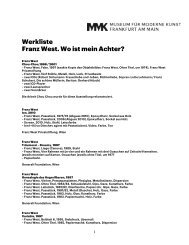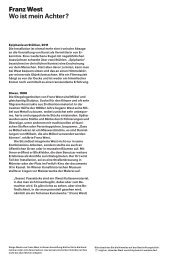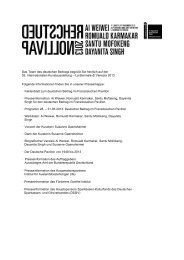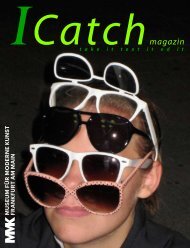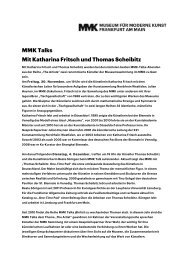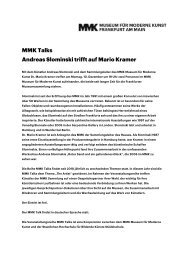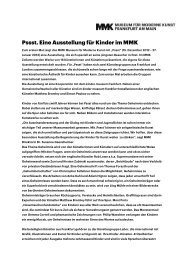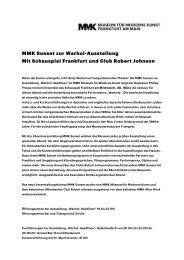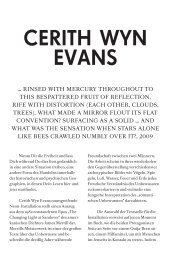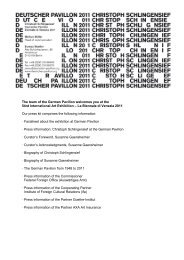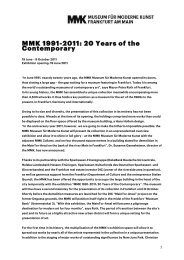Andy Warhol - Museum für Moderne Kunst
Andy Warhol - Museum für Moderne Kunst
Andy Warhol - Museum für Moderne Kunst
Erfolgreiche ePaper selbst erstellen
Machen Sie aus Ihren PDF Publikationen ein blätterbares Flipbook mit unserer einzigartigen Google optimierten e-Paper Software.
seits voll Mitleid <strong>für</strong> diese junge Frau sowie ihr<br />
tragisches Schicksal und bewundert ihre Stärke in<br />
solch einem Moment, so scheint die serielle Wiederholung<br />
des Bildmotivs gleichzeitig auch das<br />
„Leid“ zu abstrahieren. Die Serien des Bildmotivs<br />
erinnern an Negativstreifen, Filmrollen oder die<br />
Fernsehwände in unseren Hi-Fi-Abteilungen und<br />
damit an eine mediale Reizüberflutung. Auch das<br />
Jackie-Bild kann der Betrachter mit seinen Augen –<br />
Bild <strong>für</strong> Bild, Reihe <strong>für</strong> Reihe – wie einen Film abfahren.<br />
So sehr uns das Motiv bewegt, so sehr mildert<br />
das Serielle die Brisanz des Inhalts ab. Scheint<br />
uns doch ein Einzelbild die Tragik und Gemütsregung<br />
eines Augenblicks viel direkter zu vermitteln,<br />
als die Wiederholung eines Images. <strong>Warhol</strong> sagte<br />
selbst zur Themenwahl: „Die Welt fasziniert mich,<br />
sie ist schön, was immer sie sonst noch sein mag.<br />
Ich bin einverstanden mit allem, was die Leute<br />
tun; da irgendjemand gesagt hat, es sei richtig,<br />
muss es schon richtig sein. Ich würde über niemanden<br />
ein Urteil fällen. Ich fand Kennedy großartig,<br />
aber sein Tod schockierte mich nicht; er<br />
ereignete sich, das war alles. Es ist nicht meine<br />
Sache, darüber ein Urteil abzugeben. Ich hatte<br />
vor, einen Film über die Ermordung zu machen,<br />
aber ich hab’s nie getan. Ich bin außerordentlich<br />
passiv. Ich nehme die Dinge hin, wie sie sind.<br />
Ich schaue bloß zu, ich beobachte die Welt.“<br />
(Nichts zu verlieren, <strong>Andy</strong> <strong>Warhol</strong> in einem<br />
Gespräch mit Gretchen Berg, S. 17)<br />
<strong>Andy</strong> <strong>Warhol</strong> hat seine Umgebung intensiv beobachtet<br />
und in seinen <strong>Kunst</strong>werken unmittelbar<br />
darauf reagiert. Neben den Jackies gab es Vervielfältigungen<br />
Elvis Presleys, Marilyn Monroes, Liz<br />
Taylors oder der Mona Lisa. Schnell wird klar,<br />
dass <strong>Warhol</strong> in seiner Themenwahl auch Anleihe<br />
bei anderen Künstlern nahm. Im Dezember 1962<br />
wurde Leonardo da Vincis Mona Lisa zuerst in der<br />
National Gallery of Art in Washington D. C. und<br />
anschließend im Metropolitan <strong>Museum</strong> of Art in<br />
New York ausgestellt. Die Persiflage auf Mona Lisa<br />
L.H.O.O.Q (1919) von Marcel Duchamp konnte<br />
<strong>Andy</strong> <strong>Warhol</strong> nachweislich 1963 bei der großen<br />
Retrospektive Duchamps im Pasadena Art <strong>Museum</strong><br />
betrachten. <strong>Warhol</strong>s dreißigfache Vervielfältigung<br />
von Leonardo da Vincis Mona Lisa – Thirty Are<br />
Better Than One (1963) lässt sich als Grundprinzip<br />
auch auf die Jackies übertragen.<br />
<strong>Warhol</strong> thematisiert das „Image Jackie“, die als<br />
Präsidentengattin in Amerika zum Massenartikel<br />
wurde. Handelt es sich bei den Bildern Jackies<br />
doch um ein historisches Dokument über den Exhibitionismus<br />
der Gefühlswerte dieser Frau, deren<br />
Emotionen zum Objekt wurden. „Die Idee Amerikas<br />
ist wunderbar – je gleicher etwas ist, desto amerikanischer<br />
ist es auch.“ (Die Philosophie des <strong>Andy</strong><br />
Jackie picture – image for image, row for row like<br />
a film. Although we are very moved by the subject,<br />
its serial presentation softens the explosiveness of<br />
the content. It would seem as if a single picture is<br />
much more capable of conveying the tragedy and<br />
emotion of a moment, than the repetition of an<br />
image. <strong>Warhol</strong> said the following on his choice<br />
of subject: The world fascinates me. It’s so nice,<br />
whatever it is. I approve of what everybody does:<br />
it must be right because somebody said it was<br />
right. I wouldn’t judge anybody. I thought Kennedy<br />
was great, but I wasn’t shocked at his death: it was<br />
just something that happened. It isn’t for me to<br />
judge it. I was going to make a film on the assassination<br />
but I never did. I’m very passive. I accept<br />
things. I’m just watching, observing the world.<br />
(Nothing to Lose, Interview with <strong>Andy</strong> <strong>Warhol</strong> by<br />
Gretchen Berg, Cahiers du Cinema in English, No.<br />
10, May 1967, p. 42)<br />
<strong>Andy</strong> <strong>Warhol</strong> was a very intense observer of his<br />
environment, and in his works of art he responded<br />
directly to what he saw. Alongside the Jackies<br />
there are also multiple pictures of Elvis Presley,<br />
Marilyn Monroe, Liz Taylor and the Mona Lisa. It<br />
becomes quickly clear that <strong>Warhol</strong> also borrowed<br />
from other artists in choosing his subjects. In<br />
December 1962, Leonardo da Vinci’s Mona Lisa<br />
was first shown in the National Gallery of Art, in<br />
Washington D. C. before being displayed in the<br />
Metropolitan <strong>Museum</strong> in New York. It is known<br />
that <strong>Andy</strong> <strong>Warhol</strong> saw the Marcel Duchamp satire<br />
of Mona Lisa L.H.O.O.Q (1919) in 1963 during the<br />
great Duchamp retrospective in the Pasadena Art<br />
<strong>Museum</strong>. <strong>Warhol</strong>’s thirty-fold reproduction of<br />
Leonardo da Vinci’s Mona Lisa - Thirty Are Better<br />
Than One (1963), follows a basic principle also<br />
applied to the Multiplied Jackies.<br />
<strong>Warhol</strong> explores the image of a woman, whose<br />
position as the President’s wife meant she was<br />
treated like some mass-produced article. In effect,<br />
the multiplied Jackies represent a historical document<br />
on how her emotional values were publicly<br />
exhibited, how her emotions became an object.<br />
The idea of America is so wonderful because the<br />
more equal something is, the more American it is.<br />
(The Philosophy of <strong>Andy</strong> <strong>Warhol</strong>, p. 101) <strong>Warhol</strong>’s<br />
repetition reinforces the impression that we are<br />
dealing with an object: Thirty-five are better than<br />
one. This principle still holds true for our present<br />
day.<br />
Marcella Sohmen<br />
Translation: Jeremy Gaines, Frankfurt am Main



